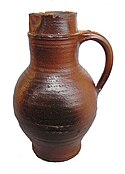BLW Bartmann Jug
1525-50
Germany, Cologne
Salt-glazed stoneware with moulded detail, and pewter lid
This unusual salt-glazed stoneware jug is an elaborate version of the mass-produced Bartmann bottle, so-called because of its applied bearded facemask. Here, though, the whole vessel is moulded in great detail to convey a three-quarter length figure of a man dressed in costume fashionable in the mid-sixteenth century. The pewter lid, openable by flicking the thumbpiece attached to the handle, doubles as the man's hat. Such a jug would have been used to hold beer or wine at the table upon which might also be found other vessels such as those the man is depicted as holding - a rather more conventional Cologne stoneware jug and a facetted green glass drinking flute.
Despite a long earthenware potting tradition from the time of the Roman occupation, the Cologne stoneware industry began rather later than that of other Rhineland towns. By about 1500, however, Cologne was producing small mugs and jugs with applied moulded botanical decoration. Although there were several thriving stoneware workshops in Cologne in the first half of the century, the city authorities were concerned about the fumes and fire risk. Prohibitions and tax increases forced many potters to leave the city to set up instead in nearby Frechen.
Relevante Bilder
Relevante Artikel
Deutsches SteinzeugDeutsches Steinzeug hat eine lange Tradition und fand nahezu in ganz Europa, Nordamerika und auch darüber hinaus Verbreitung. Seit etwa der Zeit um 1300 wurde Steinzeug im deutschsprachigen Raum produziert. .. weiterlesen



